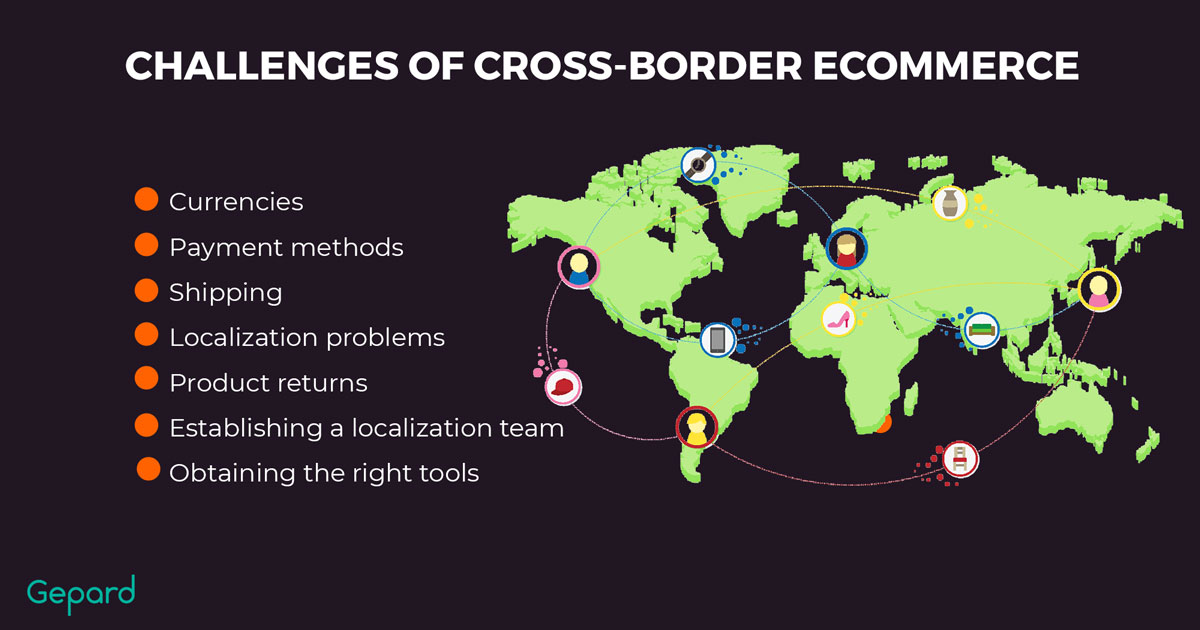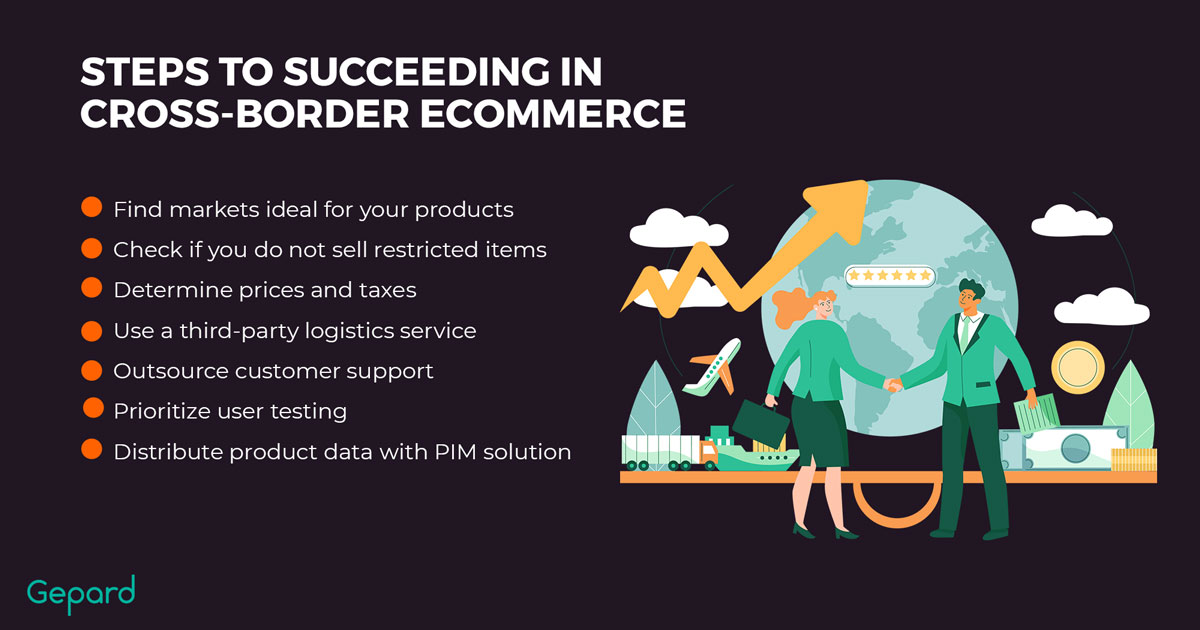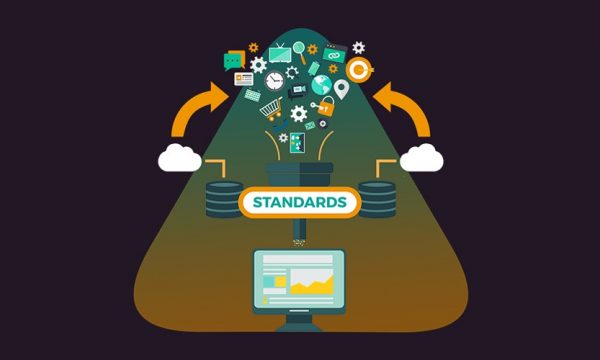Cross-Border eCommerce: Full Overview Guide [2025]
Online shopping, particularly cross border e Commerce, has witnessed exponential growth since its advent. Based on Statista it has accounted for 22% of all tangible products’ shipments in 2022 – a 7% increase from 2016.
As one of the best ways to access international customers, cross-border eCommerce is a trading practice that is quietly taking over the eCommerce industry. So, what exactly is it?
What Is Cross-Border eCommerce?
What makes it more appealing — and is significantly fuelling its popularity — is the fact that it is open to both physical store owners and those whose businesses are purely online.
Benefits Of Cross Border e Commerce
The growing number of eCommerce websites and the straightforward VAT registration procedures have remarkably simplified selling beyond borders. These, coupled with predictions of new booming markets such as Greece, are encouraging entrepreneurs to take advantage of this opportunity for business growth.
Currently, major players in the industry such as Alibaba, AliExpress, eBay, and Amazon are trading products overseas at impressive rates. They seem unstoppable. In fact, Cision projects that the market size of cross border e Commerce will reach $1508700 million by 2027. So, what is fuelling this growth? What makes it so popular?
Here are reasons why cross-border eCommerce is important.
- International expansion opportunities
Selling overseas opens your brand up for bigger and better business opportunities. Take Apple, for instance. The company has an online store, Apple.com, where international consumers purchase products specific to their locations. By accessing these newer markets, the company gains a competitive edge, increasing its overall bottom line.
- Demand all year round
Centralizing business opportunities in one area can be devastating, especially in seasons when the demand for goods decreases. Cross-border eCommerce alleviates such problems by allowing you to take advantage of the different market cycles around the globe.
Vetements is an excellent example of a fashion brand in Switzerland that leverages cross-border eCommerce to sell products all year round. The company can, for example, sell its winter collections to global consumers, even when Switzerland is enjoying the summer – and vice versa. So, if one region experiences a dip, the company can focus on areas experiencing business peaks.
- Brand awareness
Brand visibility is one of the moving parts of business success. Selling in the international market places you in front of the consumer, identifying you as a market leader. Especially if you offer products of unmatched quality, creating a global following of enthusiastic shoppers is an immediate possibility.
Gucci is one such company that has witnessed increased brand visibility as a result of cross-border eCommerce. According to Statista, the renowned fashion brand generated an impressive 36% of its 2022 sales from Asia-Pacific, compared to 29% generated from North America.
- Maximizes selling of low-demand domestic eCommerce products
Selling products that are unpopular in your region can be challenging. Luckily, the international market opens you up to new customers who are in dire need of your product, pumping your revenues and increasing business sustainability.
LONGi, the biggest PV provider, has been leveraging cross-border eCommerce to deliver high-quality solar panels across the globe. According to PV Magazine, the company saw an increase in market share, rising to 19% in 2020.
- Increased access to end customers
Expanding globally means gaining access to more end consumers. Fubu, which started in Daymond John’s (the CEO) basement, has now tapped into the global market, selling to millions of consumers across borders.
- Builds a good customer relationship
Cross-border eCommerce presents a surefire opportunity for brands to build healthy and fruitful customer relationships. ‘Nike By You” is an excellent example of an international selling strategy that the footwear and apparel giant is using to foster better relationships with its global markets.
- Increased business sustainability
The modern consumer is keen on sustainable businesses. Cross border e Commerce has pushed brands to embrace business sustainability to make their local and international consumers happy. A company like Intel is taking on corporate responsibility by recycling 75% of its waste.

Challenges Of Cross-Border eCommerce
Just like any other business model, international eCommerce has its pitfalls. However, brands need to understand these challenges to help them create a holistic strategy as they scale globally.
Let’s delve into the specifics.
- Currencies
Managing foreign currencies is one of the biggest hurdles international businesses are facing. After shopping for products, many consumers will leave an eCommerce website prematurely because they cannot convert the prices into their local currencies. Brands need to install applications that will automatically convert the currencies.
- Payment Methods
Online payment processing is another notable challenge in selling globally. In Africa, for instance, digital payment is fragmented, and consumers may not have access to various payment methods.
To counter such challenges, brands must find out the most popular payment methods in their target countries. They can then adopt the missing payment solutions into their systems to increase conversions.
- Shipping
Delays in custom clearance, human error, improper handling of merchandise, and tech issues are some of the problems sellers experience when shipping products internationally.
To minimize these challenges, an entrepreneur must consider shipping times, duties, and taxes, as well as the tools and resources they need for successful shipping.
- Establish A Localization Team
Finding expert translators is a factor that might hurt a company’s effort to establish its authority overseas. A subpar team is prone to make translation errors, which undermine communications efforts, threatening business longevity. Do due diligence and find a solid localization team that understands your business. It’s the only way you can adapt your products and content to the locals’ liking, increasing your customer base.
Read more about building a strong eCommerce team:
- Returns
Horror stories of ‘online shopping has gone wrong’ are not unheard of. As such, online consumers are cautious about the items they purchase, especially when they lack a return policy. Including a return policy is an excellent cross-border eCommerce strategy that not only reassures customers of their value but also showcases the company’s confidence in its products.
- Obtain the right tools
Managing product information is a complex task, especially if a company sells a ton of products. To ensure the circulation of accurate product information, a company must invest in advanced systems like PIM that allow them to monitor and manage product descriptions across all eCommerce marketplaces.

Steps To Succeeding In Cross-Border eCommerce
enturing into cross border e Commerce is a sure-fire way to create an internationally-renowned brand. It provides a money-making opportunity, strategically positioning a company for longevity.
However, that’s easier said than done. Here are the steps every entrepreneur must take to succeed in cross border business.
Find Markets Ideal For Your Products
As exciting as global expansion can be, undertaking eCommerce by country is a great approach. Start by identifying outside markets that take a keen interest in your products. Then, do due diligence and assess those with a favorable business climate, conquering one market at a time.
Check If Your Products Fall Under Restricted Trade Items
Various foreign markets have unique product restrictions that affect eCommerce. The government or other international bodies lay out these restrictive measures.
Some of the cross-border eCommerce examples of restricted products include medication, food, beverages, alcohol, disinfecting devices, and many more. So, to prevent bans in global markets, make sure your merchandise does not fall under these restrictions.
Determine Prices And Taxes That Affect Your Intended Market
International taxes can be complex. To improve your chances of excelling in cross-border e-Commerce, ensure that your company aligns with the foreign market’s taxation requirements. You also need to be conversant with competitor prices on similar merchandise as well as distribution and other overhead costs.
Leverage The Services Of A Third-Party Logistics Service
Shipping overseas is a headache that eCommerce businesses understand oh too well! To diligently fulfill orders and ensure customer satisfaction, working with a third-party logistics company equipped with logistics management software is an excellent move. The company will take complete control of the entire shipping, offering additional services such as warehousing and distribution.
Outsource Customer Support
Language barriers are frustrating. When consumers find difficulty expressing themselves or conversing with your customer service desk, your business is in trouble. To help you seamlessly handle all verbal and nonverbal communications with the locals, consider hiring a cross-border e-Commerce customer service provider.
Prioritize User Testing
Reading a myriad of cross border e Commerce reviews will not equip you with enough knowledge to offer customers an unmatched shopping experience. Conducting website user testing before launching is of the utmost importance. Considering that consumer behaviors differ, doing so allows you to sneak a peek at what to expect. User testing helps you identify website features ideal for your target market and invaluable target consumer feedback. It gives valuable insight into the customer experience, allowing you to make changes where needed before operations commence.
Automate Product Content Distribution Across Multiple Channels With PIM Solution
To maximize returns on the international market, showcasing your products on an array of eCommerce and social media channels is the way to go. However, managing product data and maintaining compliance can be challenging. PIM solutions such as Gepard will seamlessly automate product data distribution across these platforms. Not only does this save time, but it also ensures that brands and consumers only access high-quality data.

The Importance Of PIM Solution For Successful Croos Border e Commerce
The longevity of cross border e Commerce is highly dependent on product data quality, among other things.
Take an apparel business, for example. The product information on the garments is vital because there isn’t any sizing standard that accommodates all body types. Ready-made garments from, for instance, Asia will have different measurements compared to apparel flown in from Australia, Europe, or North America. Indicating an incorrect size is likely to infuriate a customer, jeopardizing any attempts at a breakthrough in international trade.
Gepard, a robust PIM or product information management solution, takes the pain out of enriching and managing product information for cross-border commerce. It elevates omnichannel eCommerce marketing, allowing companies to sync up-to-date item descriptions across all global selling platforms.
The application has a range of features designed to help you take control of product information. First, it has advanced rights management tools that prevent unauthorized data editing and management. Secondly, its business rules engine automates predefined processes, while its versioning and publication feature keeps a record of the different product data versions.
Gepard also leverages product data standardization, which ensures all products are showcased as required by each marketing channel. It verifies descriptions, making sure they comply with data standards such as ETIM, EPREL, and GDSN. In addition, its eCommerce localization feature adapts your content to local cultures, creating an unparalleled shopping experience.
Read more about the challenges and benefits of product data standardization:
What’s more, the application eliminates possible errors by validating workflows. Clients particularly find its product attribute optimization feature appealing for the provision of high-quality data across all platforms. Additionally, Gepard has a connections hub that allows multiple integrations with international marketplaces, retailers, content providers, and eCommerce platforms, empowering its users with more opportunities for cross-border eCommerce.
These are only a few of the exceptional features that Gepard PIM offers. Trust that it will elevate your consumers’ product experience, further enhancing the popularity of your trade items.
Cross-Border eCommerce FAQ
What Is Cross-border eCommerce With Examples?
Cross-border eCommerce is a business expansion strategy where brands join or build online eCommerce marketplaces to tap into the lucrative international market and sell their products overseas.
An excellent example is a furniture or electronics company in China, selling its products to consumers in the United States via Alibaba.
What Does eCommerce Localization Mean?
This is the process of adapting a website’s content to the culture of its international market. The aim is to make it indistinguishable from the local contents.
What Is Omnichannel eСommerce?
This is an eCommerce strategy where brands create an unmatched shopping experience across all online and offline marketing platforms. The clients will have a unified and satisfactory buying experience whether they walk into a physical store or log onto their iPads to purchase a product.
How Bright Is The Future Of Cross-Border eCommerce?
Cross-border eCommerce is undeniably a phenomenal way to boost brand visibility and establish your company as a market leader. It opens up a business to a diverse customer base and is here to stay.
But, to make this happen, the importance of maintaining superior quality data is vital. Companies also need to address the challenges involved with managing the data across all international eCommerce platforms.
That’s where a PIM system comes in! Gepard PIM will help your team effectively manage data, create an unforgettable product experience, and provide a high level of service to your customers around the world. In turn, you will experience increased revenues, more lucrative business opportunities, and a faster time to market.
Want to try the platform to scale your business to greater heights? Request a personalized demo to see how Gepard can help you.







